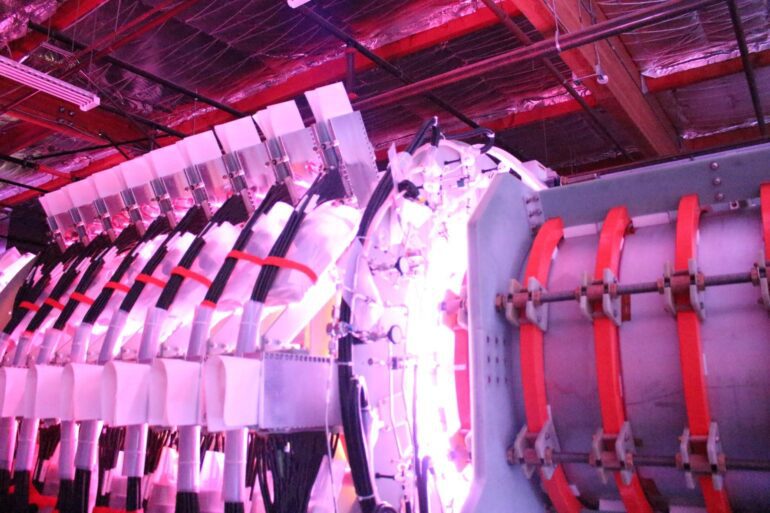TL;DR:
- Helion Energy, a nuclear fusion energy pioneer, plans to have a commercial-scale power plant running within five years.
- Microsoft has expressed interest in purchasing electricity from Helion’s fusion power plant.
- Helion has received backing from tech industry billionaires, including Sam Altman, Reid Hoffman, and Dustin Moskovitz.
- US energy group Constellation will handle power marketing and transmission for Helion.
- The timetable for the plant’s deployment is significantly ahead of previous projections.
- Helion aims to produce power from its seventh prototype next year.
- The company’s long-term goal is to deliver power at $0.01/kWh, half the cost of the cheapest onshore wind generation.
- Microsoft sees fusion energy as an important technology for transitioning to clean energy.
- Fusion technology has faced skepticism due to the challenges involved and the presence of alternative renewable energy sources.
Main AI News:
A ground-breaking nuclear fusion energy pioneer, supported by a triumvirate of tech industry tycoons, has made a bold assertion that it can establish a commercially viable power plant within a mere five years, with tech giant Microsoft eagerly waiting to procure its electricity.
Based in the United States, Helion Energy has set its sights on launching its inaugural plant by 2028, boasting a rated capacity of “50MW or greater” following a one-year ramp-up phase. Backing the ambitious venture are a trio of deep-pocketed US tech pioneers: Sam Altman, the CEO of OpenAI; Reid Hoffman, the co-founder of Facebook; and Dustin Moskovitz, also a co-founder of Facebook.
Microsoft, a renowned industry leader, has secured its position as the primary buyer of the electricity generated by Helion’s pioneering efforts. This momentous deal is hailed as the world’s first fusion power agreement, aiming to harness the boundless potential of the sun’s reactions to produce abundant, on-demand, and carbon-free energy, effectively mitigating the significant drawbacks associated with its nuclear fission counterpart.
Power marketing and transmission responsibilities will be assumed by US energy group Constellation, although specifics regarding the power purchase agreement are yet to be disclosed. Helion concedes that its timetable is “significantly sooner than typical projections for the deployment of commercial fusion power,” as even the most optimistic forecasts had previously targeted the early 2030s.
CEO David Kirtley acknowledges the arduous journey ahead, stating, “We still have a lot of work to do, but we are confident in our ability to deliver the world’s first fusion power facility.” Like numerous other pioneers in this burgeoning sector, Helion races against time to validate the technical prowess of its fusion technology and expedite its path to commercialization, positioning itself as a key player in the ongoing energy transition.
Anticipating a pivotal milestone, the company aims to generate power from its seventh prototype in the coming year, proudly asserting its position as the first privately held fusion developer to achieve plasma temperatures of 100 million degrees. As part of its long-term vision, Helion strives to provide power at a remarkable rate of $0.01 per kilowatt-hour (kWh), approximately half the cost of the most economical onshore wind generation witnessed globally.
Microsoft President Brad Smith expresses optimism, remarking, “We are optimistic that fusion energy can be an important technology to help the world transition to clean energy.” Despite the mounting enthusiasm surrounding this technology, the immense complexity of the underlying physics has long been the target of derision, with the notion that “fusion is always 30 years away” serving as a standing joke within the field.
Detractors further contend that the affordability of wind and solar power, in conjunction with advancements in storage technologies, smart grids, and the vast potential of green hydrogen, may undermine fusion’s viability even before it takes its initial steps.
Conlcusion:
The emergence of Helion Energy and its ambitious plans to establish a commercial-scale fusion power plant within five years, along with the support from tech industry giants and the interest of a major player like Microsoft, signifies a significant development in the energy market. This indicates a growing recognition of fusion energy as a potential solution for the global transition to clean and sustainable power sources. If Helion successfully delivers on its promises, it could disrupt the energy landscape, offering a new and reliable source of electricity with the potential for lower costs.
However, the skepticism surrounding fusion technology and the already established presence of alternative renewable energy sources such as wind and solar power, along with advancements in storage and smart grid technologies, suggest that the market for fusion energy will continue to face challenges.
Nonetheless, the progress made by Helion and its backers underscores the increasing importance of innovative and disruptive solutions in the pursuit of a cleaner and more efficient energy industry. Businesses operating in the energy sector should closely monitor these developments and evaluate the potential impact on their strategies and market positioning.

